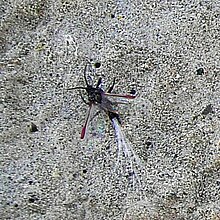Armenian cochineal
| Armenian cochineal | |
|---|---|
 |
|
| Porphyrophora hamelii (female) | |
 |
|
| Porphyrophora hamelii (male) | |
| Scientific classification | |
| Kingdom: | Animalia |
| Phylum: | Arthropoda |
| Class: | Insectacar |
| Order: | Hemiptera |
| Superfamily: | Coccoidea |
| Family: | Margarodidae |
| Genus: |
Porphyrophora Brandt, 1833 |
| Species: | P. hamelii |
| Binomial name | |
|
Porphyrophora hamelii Brandt, 1833 |
|
| Synonyms | |
The Armenian cochineal (Porphyrophora hamelii (Brandt)), also known as the Ararat cochineal or Ararat scale, is a scale insect indigenous to the Ararat plain and Aras (Araks) River valley in the Armenian Highlands. It was formerly used to produce an eponymous crimson carmine dyestuff known in Armenia as vordan karmir (Armenian: , literally "worm's red") and historically in Persia as kirmiz. The species is critically endangered within Armenia.
The Armenian cochineal scale insect, Porphyrophora hamelii, is in a different taxonomic family from the cochineal found in the Americas. Both insects produce red dyestuffs that are also commonly called cochineal.
Porphyrophora hamelii is one of the ancient natural sources of red dye in the Middle East and Europe, along with the insect dyes kermes (from Kermes vermilio and related species), lac (from Kerria lacca and related species), and carmine from other Porphyrophora species such as the Polish cochineal (Porphyrophora polonica), and the plant dye madder (from Rubia tinctorum and related species). It is possible that Armenian cochineal dye was in use as early as 714 B.C., when the Neo-Assyrian king Sargon II was recorded as seizing red textiles as spoils of war from the kingdoms of Urartu (the geographic predecessor of Armenia) and Kilhu. The Roman-era physician and pharmacologist Dioscorides, writing in the 1st century A.D., noted that the best kokkos baphike, the kermes shrub and its "grain" (kermes insect) that some ancient writers likely confused with Porphyrophora hamelii, came from Galatia and Armenia. In the Early Middle Ages the Armenian historians Ghazar Parpetsi and Movses Khorenatsi wrote specifically of a worm-produced dyestuff from the Ararat region.
...
Wikipedia
